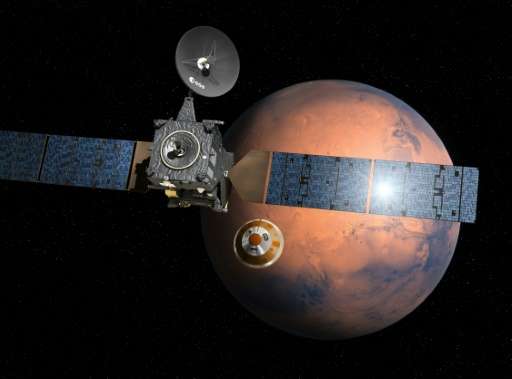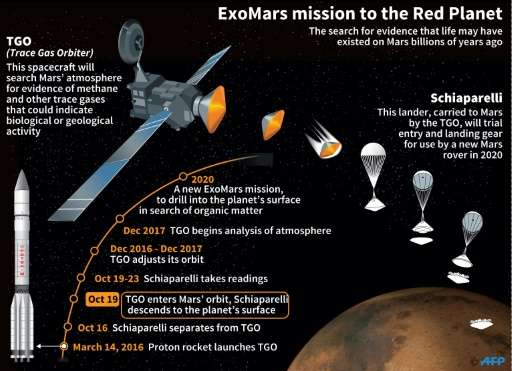Mars explorer duo on course: ESA

European-Russian spacecraft were on course for Mars Monday after crucial deep-space manoeuvres in preparation for a daring mission to find evidence of life on the Red Planet.
The Trace Gas Orbiter (TGO) mothership despatched the tiny Mars lander called Schiaparelli Sunday on a three-day trek to the Martian surface in a key phase of the joint ExoMars project.
There were nervous moments for ground controllers when the TGO, designed to enter Mars' orbit to analyse its atmosphere for signs of life, stopped sending status updates for about an hour before coming back online.
In the early hours of Monday, the TGO successfully completed a planned manoeuvre to change course to avoid joining Schiaparelli on the Martian surface, the European Space Agency said.
"Firing its engine for about 1m 46s raised the TGO's orbit by several hundred km 'above' the planet, ahead of its planned orbit insertion on Wednesday," the agency wrote on its ExoMars blog.
And deputy flight director Micha Schmidt tweeted from mission control in Darmstadt, Germany: "on track for next big event: orbit insertion #ExoMars".
The TGO and Schiaparelli, launched into space in March, comprise phase one of the ExoMars mission.
The TGO, with 600-kilogramme (1,300-pound) Schiaparelli on board, travelled seven months and 496-million kilometres (308 million miles) from Earth before Sunday's separation.
It then headed for Mars orbit while the paddling pool-sized lander began a million-kilometre descent to the surface, where it is scheduled to arrive on Wednesday.
ExoMars is Europe's first attempt at reaching our neighbouring planet's hostile surface after its first failed bid 13 years ago to place the first non-American rover on Mars.
The TGO's job will be to sniff the Red Planet's thin, carbon dioxide-rich atmosphere for gases possibly excreted by living organisms, however small or primitive.

Life underground?
Schiaparelli's purpose, in turn, is to test entry and landing technology for a subsequent rover which will mark the second phase and high point of the ExoMars mission.
After a two-year funding delay, the rover is due for launch in 2020, arriving about six months later to explore the Red Planet and drill into it, in search of extraterrestrial life—past or present.
While any life is unlikely to be found on the barren, radiation-blasted surface, scientists say traces of methane in Mars' atmosphere may indicate there is something underground, possibly single-celled microbes.
Mars has become a graveyard for many a mission seeking to explore a planet that has captured the human imagination for millennia.
Since the 1960s, more than half of US, Russian and European attempts to land and operate craft on the Martian surface have failed.
The last time Europe tried, the British-built Beagle 2 disappeared without a trace after separating from the Mars Express mothership in December 2003.
It was finally spotted in a NASA photo in January 2015.
Mars landers must be built to survive a long trip from Earth, then a supersonic, scorching journey through Mars' carbon dioxide-rich atmosphere.
Elongated orbit
They require protection against a heat of several thousand degrees Celsius generated by atmospheric friction, extreme braking, and a soft touchdown in terrain where jagged rocks or craters could spell doom.

Schiaparelli should reach the atmosphere at an altitude of 121 kilometres and a speed of nearly 21,000 kilometres (13,000 miles) per hour on Wednesday.
The extreme ride through Mars' atmosphere will take six minutes.
A discardable "aeroshell" will protect the lander against the heat generated by atmospheric drag, while a supersonic parachute and nine thrusters will brake it.
A crushable structure in the lander's belly is meant to cushion the final impact.
It is the first time this entry and landing combination is used, and the lessons learnt will be crucial to plan a safe landing for the much bigger and more expensive rover to follow.
With a 10-minute delay—the time it takes for a message to reach Earth—Schiaparelli will send data on temperature, humidity, density profile and electrical properties.
Battery-driven and without solar panels, the lander should last for two or three days.
The TGO will on Wednesday enter an elongated and erratic Mars orbit.
It will then start a 12-month process of "aerobraking"—skimming the Martian atmosphere to bleed off energy—to change its orbit into a more regular, circular one.
Once this is achieved, in early 2018, it will begin its work of sniffing the Mars atmosphere from about 400 kilometres for methane.
© 2016 AFP




















